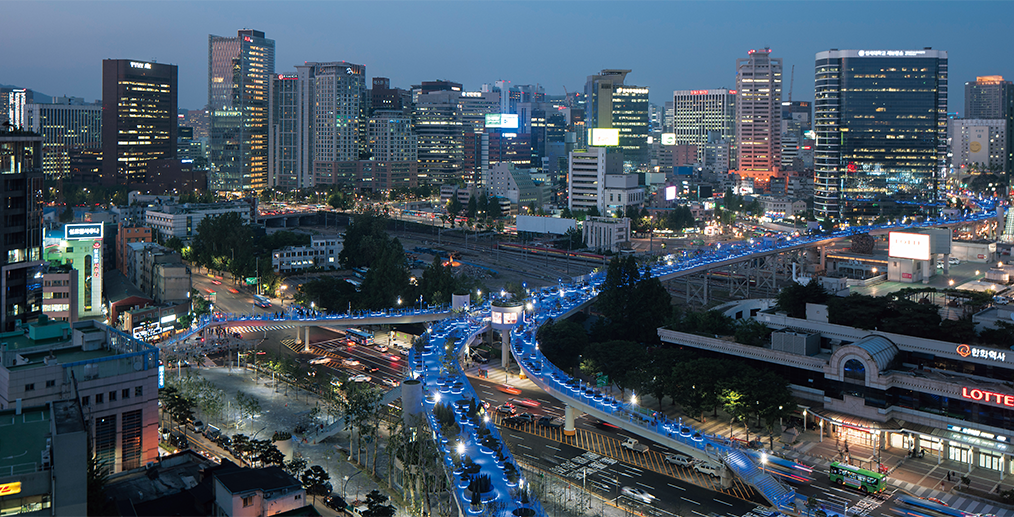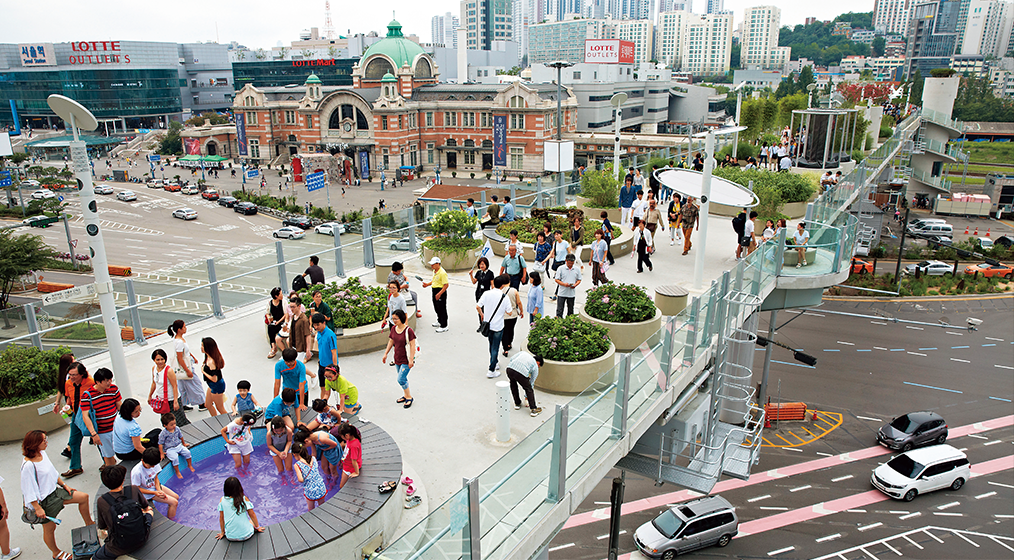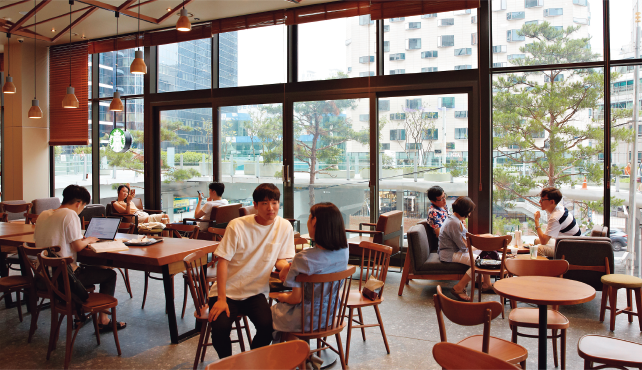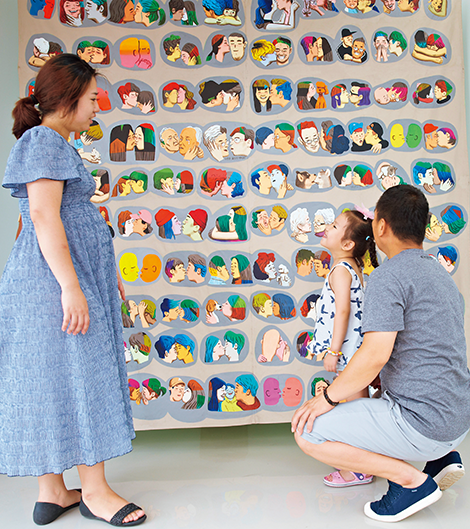The Seoul Station Overpass, built in 1970 to connect the east-west traffic flow
around the city’s major railway station, was once seen as a symbol of Korea’s rapid economic growth.
Recently, it was reborn as Seoullo 7017, an elevated walkway and garden in the heart of the city.
It has emerged as a popular new attraction of Seoul, but critics continue to argue that
the public architecture project was carried out without proper consensus.

Viaducts are usually found in scenic mountains with deep valleys. They are built to connect hiking trails and provide better views of the landscape by overcoming geographical limits. In the sense that they change the hiker’s body movement from following the topography to transcending the natural setting, they are structures of high importance.
These poetic structures do not exist in the mountains only. There are also sky bridges over urban valleys between high buildings, connecting vital points in the flow of the city. Seoullo 7017 is such a case. Formerly a part of Seoul’s transportation infrastructure, the overpass has been transformed into a rest area for pedestrians.
In the past, people who crossed the overpass by bus or car had the opportunity to catch a glimpse of the cityscape from a height no pedestrian could reach. Now, however, the situation is reversed as the overpass has been remodeled to allow pedestrians to enjoy the view of that very cityscape at a slow, relaxing pace as they stroll along the newly opened walkway or sit and relax under the trees planted in large pots where once cars were stuck in traffic. Just the thought of looking down on the heavy rails passing through Seoul Station and promenading over the city as if walking on clouds is pleasing enough; this is exactly what happens on Seoullo 7017.
Shift in the Public Space Paradigm
The old overpass ran 1.15 kilometers from Namdaemun-ro 5-ga to Manri-dong and connected neighboring areas cut off by the railroads running through the city. It had helped to smooth the traffic flow in the heart of Seoul, covering Seoul Station, Namdaemun Market and the Myeong-dong area, and served as a kind of artery administering oxygen to the tissue of the city.
With the start of the new millennium, however, a discussion began regarding the demolition and rebuilding of the overpass due to its deterioration, at the end of which, in spite of the various opinions offered by merchants and residents of the neighboring areas, the Seoul Metropolitan Government made the independent decision to turn the overpass into an urban park. Subsequently, an international design competition was held and the project proceeded at lightning speed.

Seoullo 7017, reborn as a public space after serving as a traffic overpass for decades, people can rest and relax in the middle of the city.
The overpass was once a symbol of urban development in the process of Korea’s rapid industrialization. From the 1970s onwards, the traffic volume on weekdays in the heart of Seoul grew rapidly due to expansion of the city’s middle class and a consequent increase in the number of cars. The traffic authority began to build interchanges at major junctions in a bid to deal with the rising traffic volume. At the time, the construction of an overpass was regarded as a proud achievement in construction technology, a necessity for industrialization and a solution to the traffic problem. The vision of an overpass running between high-rise buildings overlapped with the image of urban development using cutting-edge technology, and about 100 of them were constructed in Seoul alone — a symbol of the city’s bright future.
Upon entering the 21st century, however, the urban lifestyle changed, and as new values regarding urban structures and spaces came to the fore, the industrialization paradigm changed considerably. Moreover, one research project after another showed that the role of overpasses in easing traffic flow was not as great as expected. In particular, the degeneration of neighboring areas prompted a stream of criticism questioning the usefulness of overpasses and inviting a change of perspective. It became evident that the poor environment of the nearby buildings and their surroundings resulted not from the traffic noise but from spatial isolation.
Social interest shifted from the function of overpasses to the spaces underneath them. In addition, the real estate boom starting in the early 2000s sparked moves to redevelop the undervalued areas languishing in the shade of the overpasses, which spurred on the advocates of demolition. The Ddeokjeon Overpass in Dongdaemun District was removed in 2002, and discussions on the demolition of overpasses and their actual execution have remained active ever since. So far, about 30 percent of Seoul’s overpasses have been torn down. Most famous among them was the Cheonggye Overpass, which opened in 1971 as an arterial road across the city’s central area and was pulled down in 2003. As a result, the surrounding areas came back to life.

Seoullo 7017 is seen through the windows of a café near Seoul Station. The new landmark has changed the cityscape viewed from nearby buildings.
From Cars to Humans
As such, the changed function of the Seoul Station Overpass is in line with the social consensus on urban spaces seen from the long-term perspective. Indeed, the change did more than resolve the spatial isolation and backwardness of adjacent areas which had usually been remedied with demolition; it transformed an existing structure to serve a different function that was considered necessary for the city.
From the outset, it was expected that a kilometer-long elevated park overlooking the train tracks of Seoul Station would give pedestrians the pleasure of a lofty stroll in the city center. As the city of Seoul announced in the planning stage, a project inspired by New York’s High Line was certainly welcome to regenerate the city’s urban infrastructure, not for cars but for people, taking into account the growing perception that a city belongs to its citizens.
The greatest attraction of Seoullo 7017, so named because it was born in 1970 and reborn in 2017 as a pedestrian passage, is the way it connects Seoul Station with major tourist attractions such as Namdaemun Market, Myeong-dong and Mt. Nam. Tourists can relax and enjoy the city view, which was impossible from underneath the overpass, and they can also experience the 600-year history of Seoul as the nation’s capital while strolling along the path leading to the Seoul City Wall.
Some people have found the blue lights on Seoullo at night fantastic, and others expressed approval of the small visitor facilities and kiosks. Those who have walked along the path applaud the fact that a walking trail has been created in the middle of the city. In particular, some 24,000 trees of 228 kinds were planted in pots to create a sky garden providing shade. As stated by the Netherlands-based architecture studio MVRDV, which was in charge of the project, when those trees take root, branch out and are clothed in time, Seoullo 7017 will become even more beautiful and establish itself as one of Seoul’s top attractions.
As the city of
Seoul announced
in the planning stage,
a project inspired by
New York’s High Line
was certainly welcome to regenerate the city’s
urban infrastructure,
not for cars but
for people, taking into account the growing
perception that
a city belongs to
its citizens.

A family looks at Lee Woo-sung’s work, “Kiss Kiss,” exhibited at Hello, Artists!, a gallery on Seoullo 7017,
operated by the Naver Culture Foundation.
Social Consensus Process Skipped
On the other hand, more than a few merchants at Namdaemun Market still believe the overpass was necessary to smooth traffic flow. Harsh criticism of certain sculptures and installations before the opening or problems like the lack of convenience facilities on the walkway have obviously resulted from hasty implementation of the project, which did not undergo the due process of gathering public opinion.
It was not the shape of the concrete flower pots or the kinds of plants planted in them that aroused people’s attention. Whether they were critical or supportive, those offering their opinions on a public architecture project in the middle of the city would always wonder, “Was the social consensus process adequate?” It is necessary, therefore, to look into whether any administrative opportunism was involved in the planning of Seoullo 7017, whether decisions were made hurriedly with a hidden political agenda, and whether the international design competition was exploited to augment the project’s prestige and publicity effect.
Looking back, architectural projects have often served political agendas due to their outstanding visual effectiveness. Ironically, however, the higher the social awareness of individuality grows, the greater the importance of public interest becomes. This is because a greater diversity of desires regarding people’s private space extends to public spaces. Thus, the key point in the planning and realization of public spaces in a modern city is the way social consensus is formed.
An urban architecture project such as Seoullo 7017 is not merely a visual accomplishment; it is tantamount to building an elevated bridge over the valley of social perspectives consistent with citizens’ diverse opinions. The process should always start with a reflection on the intended purpose of a given project and the public’s values.
In the past several months since its opening on May 20, Seoullo 7017 has turned into a different space, with the trees having grown noticeably in the meantime. As the trees take root and grow, it is expected that the love and interest of Seoulites for the walkway will also grow.